The history of the pyramids has many chapters:
|
Other places this history has been told:
|
The Icehouse Games Era (1987-1995)
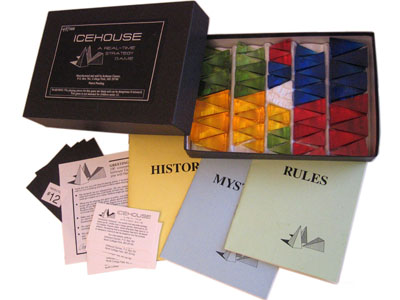 The concept of the pyramids was invented in the summer of 1987, when Andrew Looney wrote a short story called Icehouse. He described an imaginary game played with small colorful pyramids, which was so inspiring that he and his friends strove to create a real-life version of the game. This first pyramid game, Icehouse, which was designed by John Cooper, based closely on Andy’s ideas, was so fascinating that Andy and his new wife Kristin started their first company, Icehouse Games, in order to publish it.
The concept of the pyramids was invented in the summer of 1987, when Andrew Looney wrote a short story called Icehouse. He described an imaginary game played with small colorful pyramids, which was so inspiring that he and his friends strove to create a real-life version of the game. This first pyramid game, Icehouse, which was designed by John Cooper, based closely on Andy’s ideas, was so fascinating that Andy and his new wife Kristin started their first company, Icehouse Games, in order to publish it.
In 1991, Andy completed a novel called The Empty City, which started with the original story about Icehouse then dove into the imaginary history of the game, which apparently had been played in the ancient lost cities of Mars 100,000 years ago. The 100 chapter novel was released online one week at a time from ’97-’99 and released as a print edition in 2002. The book is still in print.
During its 8 year run Icehouse Games produced small runs of game sets using hand-poured plastic resin, stained wood, and eventually, as manufacturing was so difficult, simply die-cut cardstock to be assembled, tab-in-slot style by the end user. At this point it occurred to Andy that, as fascinating as the game of Icehouse was, perhaps other, even better games, could be designed with Icehouse Pieces, which is what the pyramids were originally known as.
Dawn of the Game System / The Golden Age of Pieceniks (1995-1999)
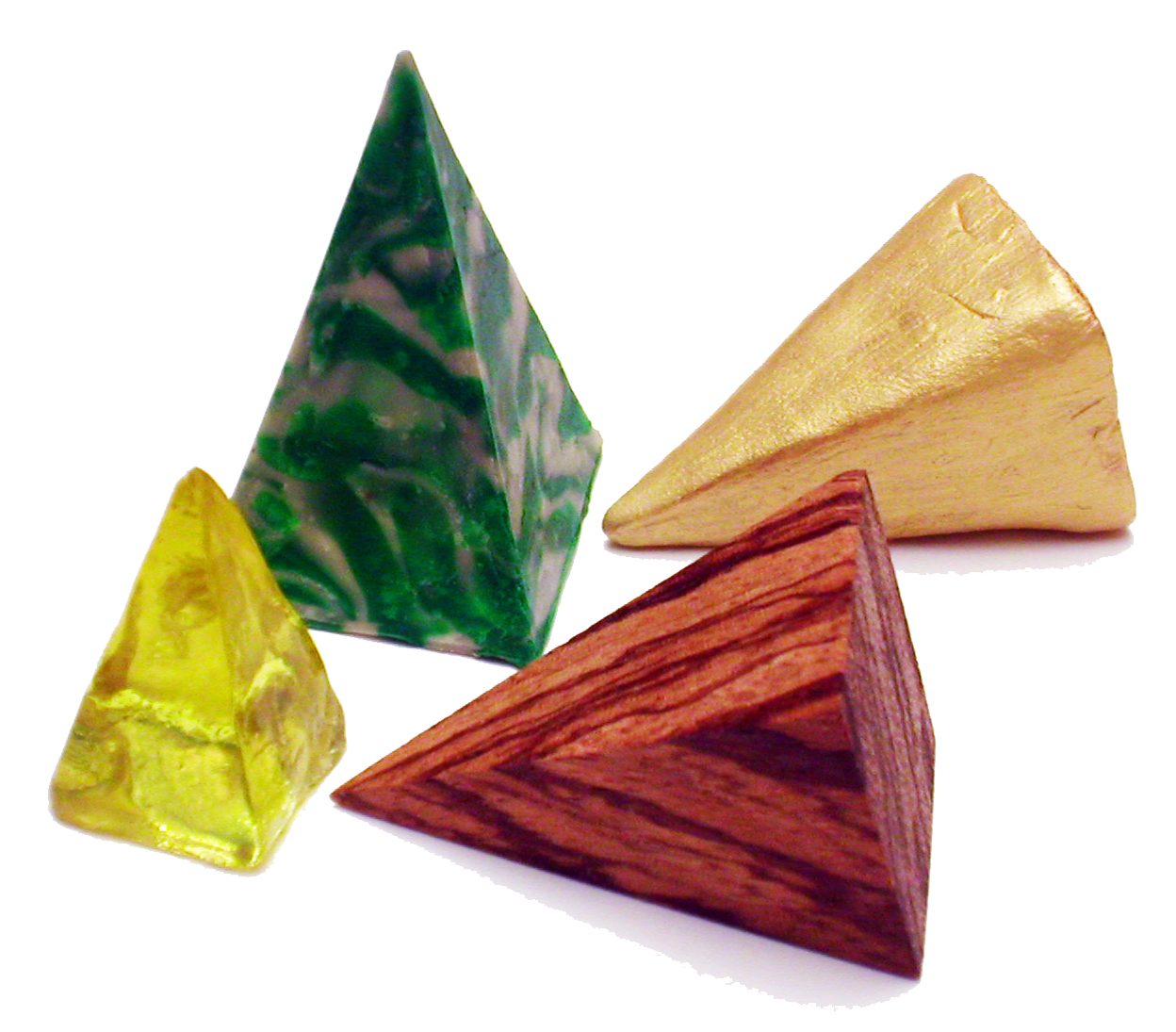 In 1995, Andy began a pyramid-game inventing spree, which continues to this day in the pyramid community. He started with Martian Chess, which he adapted from his earlier chess variant, Monochrome Chess, and went on to invent two other pyramid games that year (Trice and Igloo), encouraging John to start doing the same. They realized that Icehouse was much more than a game, it was a game system.
In 1995, Andy began a pyramid-game inventing spree, which continues to this day in the pyramid community. He started with Martian Chess, which he adapted from his earlier chess variant, Monochrome Chess, and went on to invent two other pyramid games that year (Trice and Igloo), encouraging John to start doing the same. They realized that Icehouse was much more than a game, it was a game system.
During the Icehouse Games era, and particularly at the end of it, the pyramids were so difficult to come by that the community was actively encouraged to make their own home-made sets, in whatever way they could. Creative fans rose to the challenge, making their own Icehouse Pieces, and dubbing themselves “Pieceniks.” This time could be called The Dark Ages of the Pyramids, when all that was commercially available was the folded Paper Ice sets, but it could also be considered The Golden Age of the Pieceniks.
Then, everything changed on July 24,1996, when Andy invented Fluxx. Kristin & Andy started a new company to publish it – Looney Labs – and by 1999 they’d made enough money from Fluxx to invest the $12K required for the injection-molding equipment needed to make “real" pyramids. This started a many-years experimentation with how best to package and bring these wonderful pieces/system to market.
Icehouse: The Martian Chess Set Era (1999-2002)
 The idea of hollow pieces was, for many years, rejected by Andy, but as they got serious about making injection-molded pieces, he realized that being able to stack the pyramids on top of each other would add a powerful new dimension to the game design usefulness of the pyramids. Before the first batch of stackable pyramids had even arrived, he’d already invented the first pyramid game to make use of stacking: IceTowers.
The idea of hollow pieces was, for many years, rejected by Andy, but as they got serious about making injection-molded pieces, he realized that being able to stack the pyramids on top of each other would add a powerful new dimension to the game design usefulness of the pyramids. Before the first batch of stackable pyramids had even arrived, he’d already invented the first pyramid game to make use of stacking: IceTowers.
Having realized that Icehouse was not the right game to promote to the wider public, and now that the pieces were embraced as a system for multiple games, this first set contained rules for four games. These had emerged as the best of the new flush of games: two by Andy (Martian Chess and IceTowers) and two by John (Zarcana and IceTraders, forerunners of Gnostica and Homeworlds, respectively). The rules for Icehouse were not included, but they were made available online, along with the rules to a rapidly-growing list of other pyramid games.
Like the Icehouse sets before it, The Martian Chess Set had fifteen pyramids each of red, yellow, green, and blue in the three sizes (5 trios per color). Most games designed during this era gave each player one color, and, using the term invented for the original game, this set of 15 pyramids per color was called a Stash.
Having an actual mold to easily turn out high-quality uniform pieces immediately sparked the desire for – what else? – more colors, and in 2000 the first color expansion, dubbed Black Ice, was published. It consisted of two stashes, one in opaque black, and one clear, in a black hemp bag with the “Icehouse” stylized logo embroidered on it. It included a "coupon" for a booklet of games for the set at some unidentified time in the future.
During this era, specifically in 2001, we also got a short run produced of giant cardboard pyramids. They were 8x the size of the table top pyramids and made only in plain white -- it was up to the consumer to paint them different colors.
Monochrome Stashes / Playing With Pyramids (2002-2006)
 The Martian Chess Set edition was packaged in an acyclic box which looked really cool but was overly prone to being cracked & broken during shipping, so when those sold through they decided to try a different approach. In light of the fact that most of the games invented at this point assigned each player a stash of a given color, and to bring down the entry-level cost, Looney Labs began packaging the pyramids in attractive clear tubes, by color.
The Martian Chess Set edition was packaged in an acyclic box which looked really cool but was overly prone to being cracked & broken during shipping, so when those sold through they decided to try a different approach. In light of the fact that most of the games invented at this point assigned each player a stash of a given color, and to bring down the entry-level cost, Looney Labs began packaging the pyramids in attractive clear tubes, by color.
Gamers could purchase tubes à la carte depending on the colors desired, and the requirements of the game they wanted to play. Meanwhile, a separate book of rules for twelve games was published, called Playing With Pyramids. Giddy with the opportunity for new colors, ten were produced at this time: red, orange, yellow, green, cyan, blue, purple, clear, black, and white, the last two both being opaque.
Many fans enjoyed this DIY take on the system, but others were more interested in the traditional “complete game in one box” approach. It was also at this time that Kory Heath invented Zendo, which quickly became many fans' new favorite. So the next marketing “experiment” was to publish a couple of single-focus products: boxed sets with one complete game.
Two games where published in this way. The first was Zendo, with the original color ratios and quantities: 60 pyramids in the four basic colors, as well as 60 tokens, 15 starter rule cards for the “master,” and a rule booklet. This was quickly followed by IceTowers, which was also a vehicle to get some of the other colors out into the marketplace. It contained cyan, white, clear, and purple, and, since the game included no other components, they included a copy of the novel that had started it all The Empty City, now freshly illustrated and bound in softback.
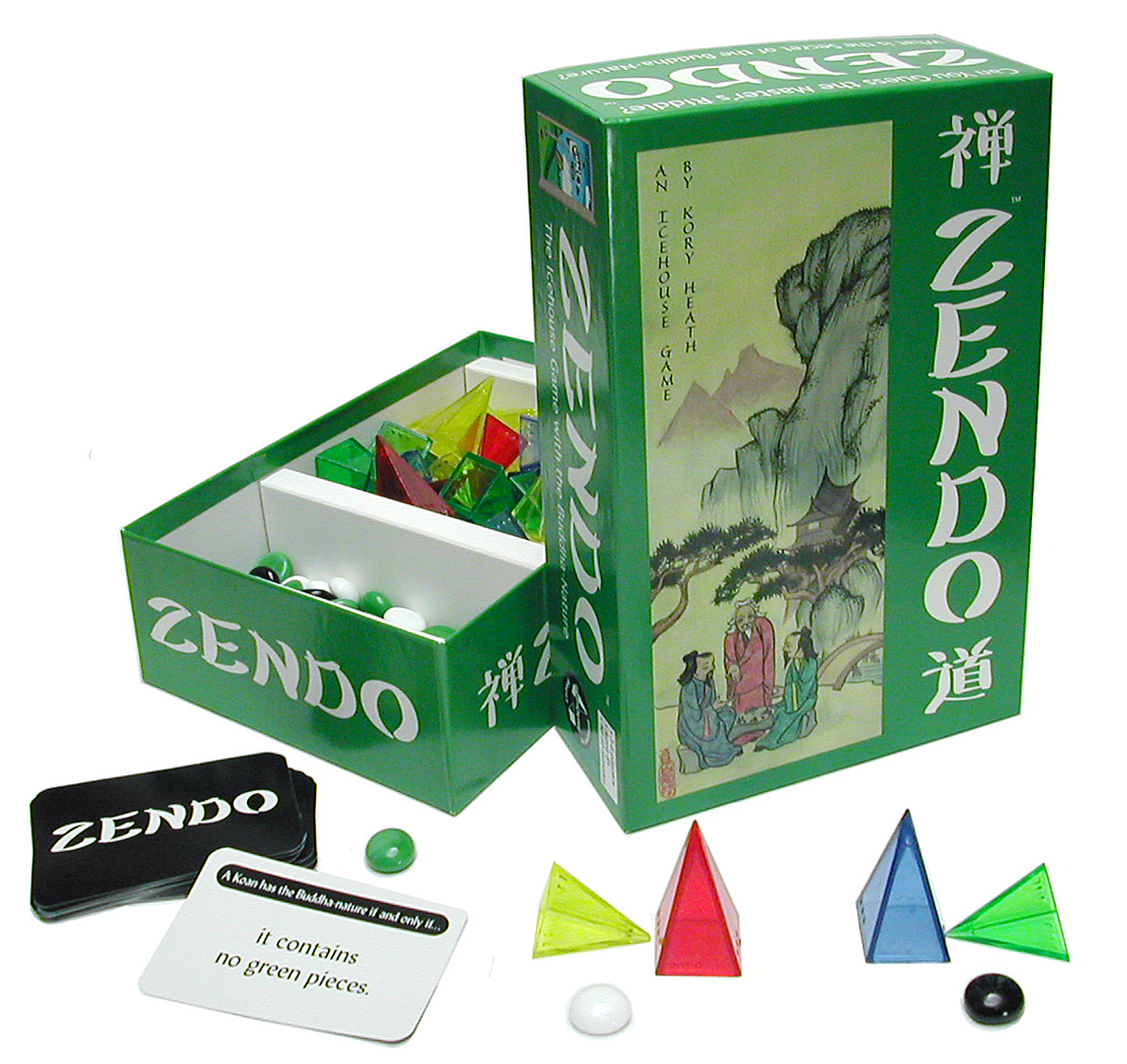
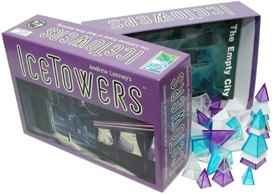
The Treehouse Era (2006-2011)
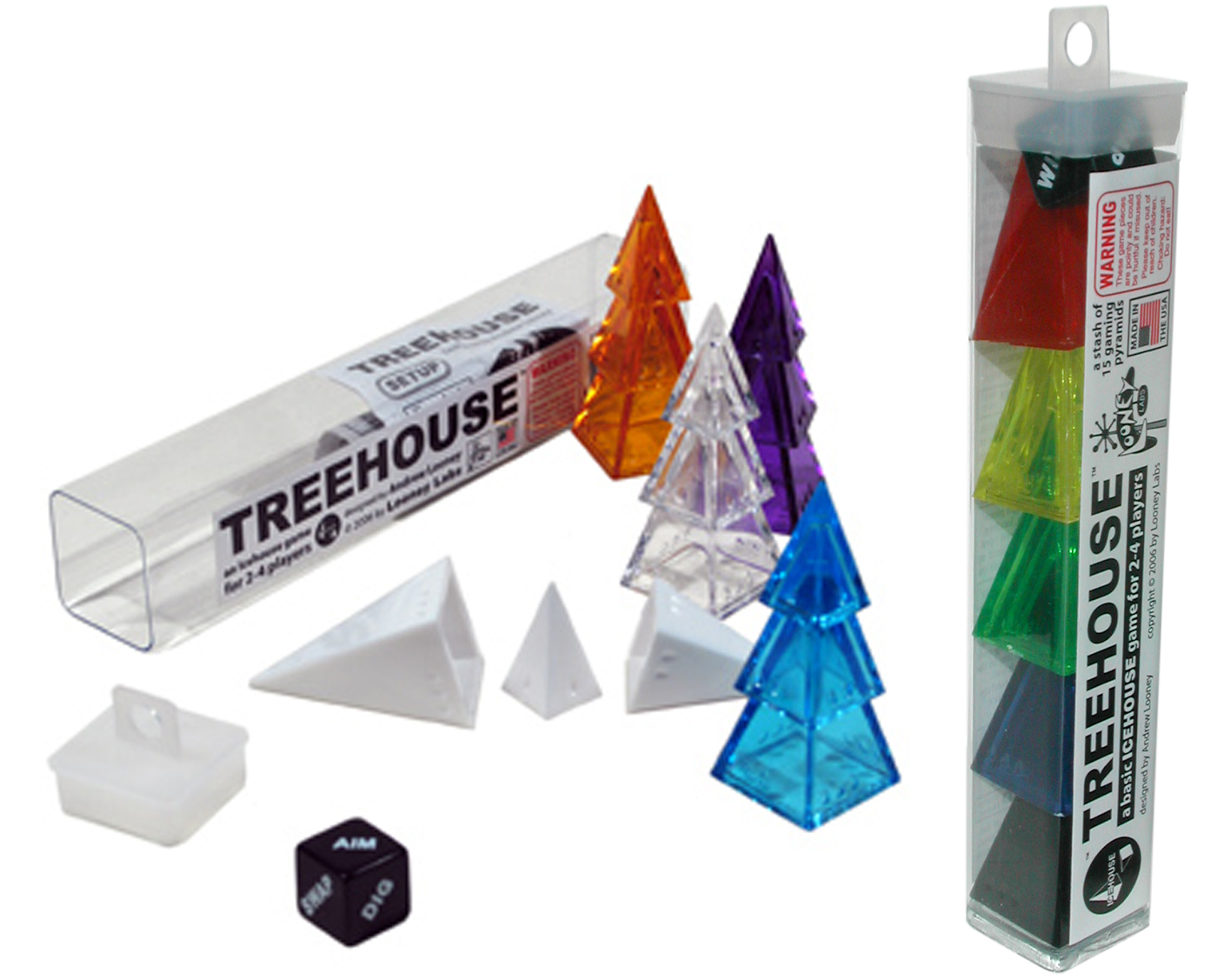 In 2006, Looney Labs was finding the need, as a growing company, to focus energy on the products that were making the most money (i.e. Fluxx) and to streamline the slower selling stuff (which is everything else, since Fluxx is a juggernaut). So Kristin challenged Andy once again, urging him to find a way to keep the system going with something both fresh and minimized. In response, Andy created Treehouse.
In 2006, Looney Labs was finding the need, as a growing company, to focus energy on the products that were making the most money (i.e. Fluxx) and to streamline the slower selling stuff (which is everything else, since Fluxx is a juggernaut). So Kristin challenged Andy once again, urging him to find a way to keep the system going with something both fresh and minimized. In response, Andy created Treehouse.
Treehouse is a simple-yet-engaging introductory game which nothing but pyramids and a custom D6, which could be tucked into the same plastic tubes they’d already been selling. But instead of monochrome stashes, Treehouse was offered in two mixed-color stashes, Rainbow (red, yellow, green, blue, black) and Xeno (clear, purple, orange, cyan, white).
The Treehouse Revolution, as Andy liked to call it, changed everything. With all the other versions of the system out of print, and the rules for all pyramid games available free on the internet, these two products were all it took to keep the system in print until the company could focus on it again. By then, there were ample games available for a set of trios of different colors, with more being invented all the time, and to get more pyramids for games that needed more, you simply bought more Treehouse tubes.
Continuing to make up new games, Andy moved into a new era of design, aiming to create games which could be played with just one of these tubes, such as Martian Coasters (later renamed Looney Ludo) or three of these tubes, such as World War 5. Andy also finally invented a game that made special use of the opaque quality of the black pyramids, called Black ICE. The rules for this game were published in a little booklet called 3HOUSE in 2007.
3HOUSE featured rules for 3 games you could play with 3 Treehouse sets: Black ICE, Martian Chess, and the two player version of Homeworlds, which Andy had nicknamed Binary Homeworlds after discovering was better when played with this more limited supply of pieces. The 3HOUSE booklet was offered free to all owners of the Black Ice product who wished to redeem that product’s coupon, but most chose to just buy the 3HOUSE booklet and keep the coupon as a souvenir.
The Pyramid Primer Era (2011-2016)
 The next step in the product line’s evolution, to many fan’s dismay, was to abandon the clear plastic tubes. (The fans most saddened by this move were the designers of games that actually made use of the tube as a game component, such as Moonshot and Drip.)
The next step in the product line’s evolution, to many fan’s dismay, was to abandon the clear plastic tubes. (The fans most saddened by this move were the designers of games that actually made use of the tube as a game component, such as Moonshot and Drip.)
Instead the pyramids would now be offered in cute little pyramid-shaped zippered cloth bags, each a different size and with differing contents. As the continued headliner, Treehouse was re-packaged in a green pyramid bag, with a bonus game (Pharaoh) included as well. The larger, blue pyramid contained the new game, IceDice, with double the pyramids and a new set of special dice. The IceDice set also featured a bonus game, Launchpad 23.
The Treehouse and IceDice sets could be combined to form a 3HOUSE set, but this new version of the system also included a pair of simple boxed expansion sets, in rainbow and xeno color schemes, but with no other equipment except a small intro booklet with overviews of a dozen of the most popular games at the time.
This little square booklet was also included in the IceDice and Treehouse sets and was a companion to the magazine-sized booklet also published at this time, known as Pyramid Primer #1, which featured the complete rules to those same dozen games.
During this time, a new color, Pink, was released, first as a monochrome Treehouse set (five trios all one color) in the classic card-game-style box. This was later replaced by Pink Hijinks, an all-pink version of Hijinks in an adorable little pink pyramid-shaped bag.
A promotional campaign we ran during this phase was something we called Cadet Training. Here's an old page about that.
The Pyramid Arcade Era (2016-present)
Something fans had long clamored for was an all-in-one giant box set, and this dream became a reality with Pyramid Arcade. Launched with a big Kickstarter campaign in 2016, this fantastic set is now available at discerning retailers around the world. Three trios each of the main ten colors, a 76-page rulebook, and all the accessories needed to play twenty-two different games, are all in this one wonderful box.
Once this was published, the pyramid bags were phased out and a new series of introductory games was created. These new games serve both as a less-daunting entry point as well as a way of adding more pyramids to Pyramid Arcade. Known collectively as Pyramid Quartet, these new game sets were launched on Kickstarter in 2020. Four smaller boxed sets, each focused on a single game (or two, in the case of Ice Duo), with different combinations of colors, depending on what direction players might want to expand their pyramid collections.
The Pyramid Quartet games are:
- Nomids, a new introductory game with one trio each of all ten colors, ideal for adding more of each other to Pyramid Arcade and a sort of mini-arcade in and of itself, with the rules highlighting 3 other games the set can be used for (Treehouse, Pharaoh, and Pyramid-Sham-Bo).
- Ice Duo (two games in one, IceDice and Twin Win) with two trios each of Red, Yellow, Green, Cyan, and Purple
- Martian Chess, with six trios of all one color, either Silver, as a Kickstarter exclusive, or Martian Red, for distribution
- Homeworlds: Andy’s favorite game in a sweet standalone edition, with three trios each of Red, Yellow, Green, and Blue

The history of the pyramids continues to be written. What new game will shake up the community next?
See Also:
- Video of Andy telling the story and showing off various early versions of the game
- PDF of the 4-page history of the system, circa 2016, which appears in the instruction booklet in Pyramid Arcade
- This out-of-date page about our out-of-date products








